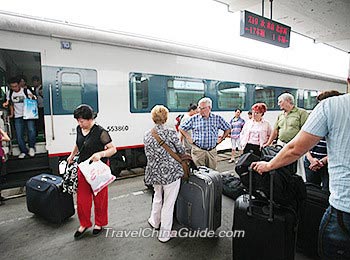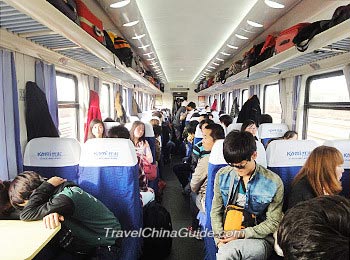China Railway Network
China railway network has a total length of 159,000 kilometers (98,800 miles) among which 45,000 kilometers (27,960 miles) are high speed railways. These railways shape a dense net covering almost every corner of China, even remote mountainous areas, Tibet on the “Roof of the World”, and Hainan Island on the sea. By 2025, the railway network in China will reach 175,000 kilometers (108,740 miles).
First of all, we will introduce several major normal speed railways, including five vertical lines running in a north-south direction and three horizontal lines traversing in an east-west direction. As completed years ago, most of them can only accommodate normal speed trains.
 Beijing-Shanghai (Jinghu) Line
Beijing-Shanghai (Jinghu) Line
First of all, we will introduce several major normal speed railways, including five vertical lines running in a north-south direction and three horizontal lines traversing in an east-west direction. As completed years ago, most of them can only accommodate normal speed trains.
Five Vertical Lines (north-south)
| Total Length | 908 miles (1,462 kilometers) |
|---|---|
| Cross-Provinces and Municipalities | Beijing-Tianjin-Heibei-Shandong-Jiangsu-Anhui-Shanghai |
| Cross-Cities | Beijing-Tianjin-Dezhou-Jinan-Xuzhou-Bengbu-Nanjing-Zhenjiang-Changzhou-Wuxi-Shanghai |
| Cross-Terrains | North China Plain-Yangtze-Huai Plain-Yangtze River Delta |
| Functions | This rail line covers a densely populated area including highly developed agricultural and industrial areas. Serving as the east artery linking north and south China, this line helps strengthen communications and also relieves transportation pressures of the eastern costal area of the country. |
| Total Length | 1,444 miles (2,324 kilometers) |
|---|---|
| Cross-Provinces and Municipalities | Beijing-Heibei-Henan-Hubei-Hunan-Guangdong |
| Cross-Cities | Beijing-Shijiazhuang-Handan-Xinxiang-Zhengzhou-Wuhan-Changsha-Zhuzhou-Hengyang-Shaoguan-Guangzhou |
| Cross-Terrains | North China Plain-Dongting Lake Plain-South China Hilly Region-Pearl River Delta |
| Functions | Jingguang line is the central axis in the Chinese railway network linking northern, middle and southern areas of the country. It is a north-south line with the highest transportation capacity. |
| Total Length | 1,538 miles (2,475 kilometers) |
|---|---|
| Cross-Provinces and Municipalities | Beijing-Tianjin-Hebei-Shandong-Anhui-Hubei-Jiangxi-Guangdong-Kong Kong |
| Cross-Cities | Beijing-Bazhou-Hengshui-Shangqiu-Huangchuan-Macheng-Jiujiang-Nanchang-Ganzhou-Longhcuan-Shenzhen-Kowloon |
| Cross-Terrains | North China Plain-Yangtze-Huai River Plain-Poyang Lake Plain-South China Hilly Region-Pearl River Delta |
| Functions | It is the main transportation artery connecting the country's southern and northern territories. This line attaches much importance to the stability and prosperity in the Hong Kong and Macau regions. |
| Total Length | 1,488 miles (2,395 kilometers) |
|---|---|
| Cross-Provinces and Municipalities | Henan-Hubei-Hunan-Guanxi |
| Cross-Cities | Jiaozuo-Luoyang-Xiangyang-Zhicheng-Huaihua-Liuzhou |
| Cross-Terrains | West mountainous region of Henan Province-Jianghan Plain-west mountainous region of Hunan Province-Gunagxi and Guangdong hilly regions |
| Functions | It nearly parallels the Jingguang line and travels through areas with rich coal resources. This line helps to relieve the stresses of coal freight and improve operation efficiencies. Meanwhile, it shares heavy passenger transport load with the Jingguang line. |
| Total Length | 1,089 miles (1,754 kilometers) |
|---|---|
| Cross-Provinces and Municipalities | Shaanxi-Gansu-Sichuan-Yunnan |
| Cross-Cities | Baoji-Chengdu-Panzhihua-Kunming |
| Cross-Terrains | Qinba Mountains-Chengdu Plain-Yunnan Guizhou Plateau |
| Functions | Along this line there are abundant natural resources, populations of ethnic minorities are also scattered around. Therefore it helps to promote the economic development of southwest area and improve the living standards of the ethnic minorities. |
|
|
Three Horizontal Lines (east-west)
| Total Length | 517 miles (833 kilometers) |
|---|---|
| Cross-Provinces and Municipalities | Beijing-Heibei-Shanxi-Inner Mongolia-Ningxia-Gansu |
| Cross-Cities | Beijing-Datong-Jining-Hohhot-Baotou-Yinchuan-Zhongwei-Lanzhou |
| Cross-Terrains | Mountainous area of northern Hebei Province-Inner Mongolia Plateau-Hetao Plain-Ningxia Plain |
| Functions | It strengthens the economic and communication networks of northern and western parts of the country. This line also relieves transport stresses on the Lanzhou-Lianyungang rail line. This line attaches much importance to overall territorial defense. |
| Total Length | 2,269 miles (3,652 kilometers) |
|---|---|
| Cross-Provinces and Municipalities | Jiangsu, Anhui, Henan, Shaanxi, Gansu, Xinjiang |
| Cross-Cities | Lianyungang-Xuzhou-Shangqiu-Kaifeng-Zhengzhou-Luoyang-Xi'an-Baoji-Lanzhou-Urumqi-Alataw Pass |
| Cross-Terrains | Huanghuai Plain - Loess Plateau - Hexi Corridor - Turpan Basin - Junggar Basin |
| Functions | Being the longest railway mainline, it links the developed east area and developing west area thereby contributing greatly in the development of economy and tourism. In addition, this line leads to China’s northwest border which is beneficial in developing international trade. |
| Total Length | 1,663 miles (2,677 kilometers) |
|---|---|
| Cross-Provinces and Municipalities | Shanghai-Zhejiang-Jiangxi-Xiangjiang-Guizhou-Yunnan |
| Cross-Cities | Shanghai-Hanghai-Nanchang-Zhuzhou-Huaihua-Guiyang-Kunming |
| Cross-Terrains | Yangtze River Delta-South China Hilly land-Yunnan Guizhou Plateau |
| Functions | This line enhances economic interaction between the country's east and southwest areas. This line is also a good helper to share the transport pressure of the Lanzhou-Lianyungang rail line. |
| Line | Travel Route | Length (km) |
|---|---|---|
| North - South Lines | ||
| Beijing - Shanghai Line | Beijing South, Tianjin West, Jinan West, Tai'an, Xuzhou East, Nanjing South, Shanghai Hongqiao | 1,318 |
| Beijing - Guangzhou Line | Beijing West, Shijiazhuang, Zhengzhou East, Changsha South, Guangzhou South | 2,298 |
| Harbin - Dalian Line | Harbin West, Changchun West, Shenyang North, Tieling West, Dalian North | 921 |
| Hangzhou - Shenzhen Line | Hangzhou East, Ningbo, Taizhou, Wenzhou South, Fuzhou South, Putian, Quanzhou, Xiamen North, Chaoshan, Shenzhen North | 1,464 |
| East - West Lines | ||
| Xuzhou - Xi'an Line | Xuzhou East, Kaifeng North, Zhengzhou East, Luoyang Longmen, Huashan North, Xi'an North | 883 |
| Shanghai – Kunming Line | Shanghai Hongqiao, Hangzhou East, Nanchang West, Changsha South, Guiyang North, Kunming South | 2,264 |
| Shanghai – Chengdu Line | Shanghai Hongqiao, Nanjing South, Hefei South, Wuhan, Chongqing North, Chengdu East | 1,985 |
| Guangzhou - Kunming Line | Guangzhou South, Yangshuo, Guilin North, Guiyang, Guiyang North, Kunming South | 1,287 |
| Lanzhou – Urumqi Line | Lanzhou West, Xining, Zhangye West, Jiayuguan South, Kumul, Turpan North, Urumqi South | 1,786 |
8 Most Scenic Train Rides in China
- Last updated on Oct. 21, 2024 by Brenda Lian -

